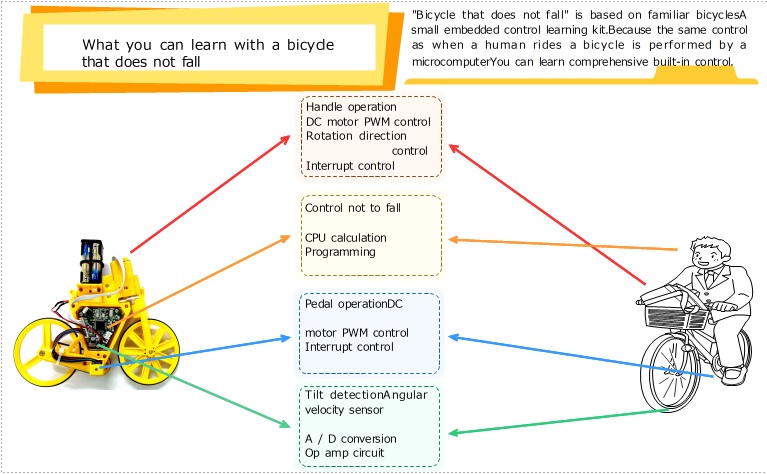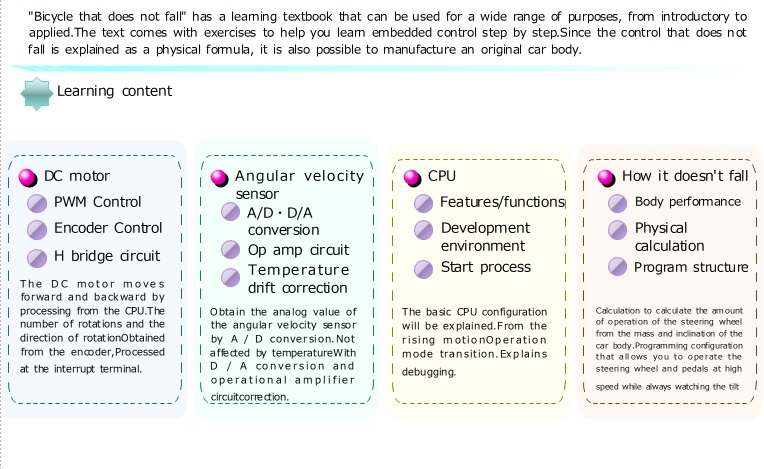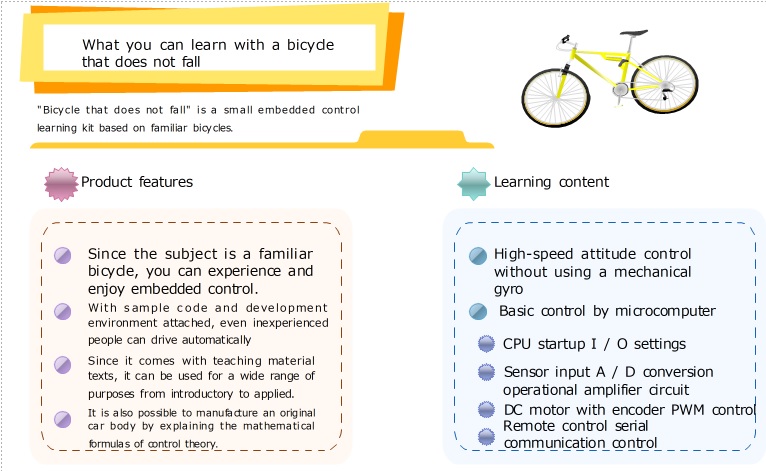
Toward the Revival of “Japanese Manufacturing”
While it has been more than ten years since a shortage of embedded technology engineers in the Japanese manufacturing industry was problematized, embedded technology itself has kept flowing overseas, without any solution having been implemented. The technological prowess of the Japanese manufacturing industry is hollowing out.
Furthermore, declining students’ interest in science and mathematics, among others, is accelerating this trend.
Our bicycle with automatic attitude control was developed as a learning material that lets students experience mechanical control, out of our wish “to let students who will play a role in the future experience fun in learning technology” and “to recover Japanese manufacturing.”
Features
A bicycle with automatic attitude control lets users polish and improve their control skills by changing design, including mechanical design, freely out of creative ingenuity. It combines an affordable price as a learning material and a degree of freedom and fun in design.
| Bicycle with Automatic Attitude Control | Product A | Product B | |
|---|---|---|---|
| Robot performance | 〇 | △ | ◎ |
| Learning material value | ◎ Can be used as a learning material for both hardware and software education. |
○ A learning material for software education |
× Too maniac to be a learning material. |
| Price | 20,000 yen | 54,000 yen to 100,000 yen | Hand made in principle |
| Degree of freedom in design | ◎ | × | ◎ |
| Enjoyability | ◎ | △ | ◎ |
| Remarks | A bicycle made by Tamaden is used as a model for modification or new design. | There is no degree of freedom as the sponsor of this competition specifies mechanism, hardware, OS, and even how to write a program. | As this competition has a long history, its level is high. Ordinary participants cannot even clear preliminaries. |
Q & A
- What is this bicycle intended for?
- It is a learning material for learning embedded control technology.
You can learn mechanical, hardware, and program design with fun.
As a learning material for embedded control consisting of a computer board only can do no more than output to a LED display, it fails to keep students interested for long.
We developed this bicycle as a learning material based on the idea that a thrill you feel when a bicycle runs smoothly or sometimes falls down as a result of a change in design makes this learning material interesting. - What technology can I learn?
- OS independent embedded control technology is mainly explained.
OS (μiTRON) embedding is also possible.
Hardware and automatic attitude control architecture are also explained in detail.
You can design your bicycle afresh from mechanical design by taking the mechanism, hardware, and program of this bicycle as a base model. You can also enhance the performance of this bicycle by changing only its program.
How to use this bicycle is up to users. One possible use is embedding a Cygwin environment or a different OS. - Is a gyro sensor used?
- A vibration-type angular velocity sensor is used to calculate the integral value of angular velocity as an angle.
- What CPU or MPU is used?
- Toshiba’s original TMP91FW27UG of TLCS900 series and ARM’s TMPM332FWUG are available.
For TLCS900 series, a textbook using both C and assembly languages and publications explaining relevant CPUs are also available.
A development environment including Toshiba genuine compiler comes free with them.
For ARM TMPM332FWUG, a trial version of IAR environment, a Cygwin environment, and Tamaden’s original simple development environment are available. - What environment is recommended for ARM development?
- Although it costs somewhat (40,000 yen), it is safe to use a trial version of IAR environment.
You’ll find yourself in a little maniac world if you download a Cygwin environment.
In light of reliability of freely downloadable compilers, Cygwin does not seem to hold up to professional use.
Tamaden’s simple tool transfers output codes (in Intel Hex format) to a target. It is bundled free. - Which is recommended, TLCS900 or ARM?
- Since a free and reliable development environment is bundled with TLCS900 and since there are abundant relevant materials, anyone can readily introduce it.
If you compare it with similar CPUs and architectures, you’ll find TLCS900 to be one of excellent cores.
While ARM is also an excellent core, the development environment cost is a bottleneck.
Just for Cortex-M3 used in the bicycle, it will cost three hundred and several ten yen if you purchase nothing but IAR genuine products.
The cost for ARM development environment poses a difficult problem for this bicycle as a learning material. - Do you offer any introductory education?
- Introductory education can be provided to schools purchasing multiple bicycles at once.
- How can I apply for a free sample?
- A free sample will be lent if you give us the name of your school and your introduction plan via Contact Form.
- Can an individual, not on behalf of a school, purchase the bicycle?
- It is possible.
- At what velocity does the bicycle run?
- This bicycle runs at about 1-3 km/h.
Just like an ordinary bicycle, the slower its velocity is, the more difficult it is to control it. It falls down if its velocity becomes zero (if it halts). Its control is easier with its greater velocity.
You can purchase the bicycle or apply for its sample here.
20,000 yen (tax not included) per unit with program development tools and a textbook
You can place an order by clicking sys@tama-den.co.jp.
If the above link does not open an email window, please send a message containing the following information to the above email address.
Your name:
Your postal code:
Your address:
Order quantity:
CPU architecture: ARM or TLCS900
Contact email address:
Contact phone number:



